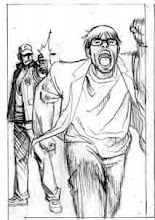June 1938 - Superman 'Action Comics #1'
Golden Age late 1940's
World War II
Shift to crime, western, and horror comics
Seduction of the Innocent by Dr. Frederic Wertham
1954 Congressional Hearings
EC Comics 'Tales From the Crypt', 'Vault of Horror'
Comics code - self-censoring ban by the publishers themselves on violence, explicit sex, gratuitous gore and the triumph of evil or antisocial behavior.
Silver Age
Flash (1956)
Green Lantern (1959)
Supergirl (1959)
JLA (1960)
Fantastic Four (1961)
Spider-Man (1963)
X-Men (1964)
Superhero Genre
Lost Parents
*the hero is marked out from society. He often reaches maturity without having a relationship with his parents
The man-god
*at least some of the superheroes will be earthbound gods in their level of powers. Other superheroes of lesser powers will consort easily with these earthbound deities.
Justice
*the hero's devotion to justice overrides even his devotion to the law.
The normal and the superpowered
*the extraordinary nature of the superhero will be contrasted with the
ordinariness of his surroundings.
The secret identity
*likewise, the extraordinary nature of the hero will be contrasted with the mundane nature of his alter-ego. Certain taboos will govern the actions of these alter-egos.
Superpowers and politics
*although ultimately above the law, superheroes can be capable of considerable patriotism and moral loyalty to the state, though not necessarily to theletter of its laws.
Science as magic
*the stories are mythical and use science and magic indiscriminately to create a sense of wonder.
Superman and the superhero emerged at the end of the Great Depression and during the run-up to the outbreak of the European war.
A new kind of popular hero had emerged: the self-reliant individualist who stands aloof from many of the humdrum concerns of society, yet is able to operate according to his own code of honor, to take on the world on his own terms, and win.
For Americans, the historical path from Munich to Pearl Harbor coincides with the emergence of Superman and Captain America - solitary but socialized heroes, who engage in battle from time to time as proxies of US foreign policy. A darker side of the Lone Wolf hero is embodied by the Batman, a hero whose motivations and emotions are turned inward against the evils within society, and even the social and psychological roots of crime itself. The tension between these two veins in the superhero tradition remains to the present day.
The mythologizing of the dangers of scientific knowledge is one of the mainstream currents of science fiction, from Frankenstein through to the famous Spock/McCoy reason/conscience conflict in Star Trek (a conflict which is spuriously resolved by the deus ex machina of Kirk's
overarching 'humanity', which embraces such contradictions and thereby resolves them.)
Langue & Parole
Superhero costumes are either sexless, denying the humanity of the hero within, or garments of great erotic significance.
Good girl art (Wonder Woman) takes the signs of pornographic discourse and integrates them into the context of non-pornographic story structures. In this way, the sign of pornography (never explicitly delivered) comes to stand in for an entire pornographic subtext, a series of blanks which readers remain free to fill in for themselves. And it is within the neo-pornographic texts of Good Girl art that the distinctions between costumed heroes and villains can first be seen to break down, a change that influenced mainstream comics.
Costume creates a community between its wearers.
All Star Comics #3 (1940)
Justice Society of America
Intertextuality forms the Marvel & DC Universes.
Serial continuity
The back-story
Hierarchical continuity
A beats B
C defeated by B
A bests C
The pressure of combat also forces from heroes the quality which sums up the moral nature of the superhero: the 'extra effort'.
Structural continuity
Serial (diachronic 'over time')
Hierarchical (synchronic 'in the moment')
Combines to produce the entire contents of the Marvel & DC Universes.
Metatext.
T.S. Eliot's 'Tradition and the Individual Talent'
"what happens when a new work of art is created is something that happens simultaneously to all the works of art which preceded it. The existing monuments form an ideal order among themselves, which is modified by the introduction of the new (the really new) work of art among them. The existing order to persist after the supervention of novelty, the whole existing order must be, if ever so slightly, altered..."
Clearly, intertextual and metatextual continuity create a subsidiary world in which the process of time can be kept under control.
Continuity, and above all metatextual structural continuity, is the strategy through which superhero texts most clearly operate as myths. Continuity provides the interaction with the audience which characterizes mythological discourse: myths...{are} 'machines for the
suppression of time', the contemplation of the unity being more important than any suspense engendered over the outcome.

No comments:
Post a Comment